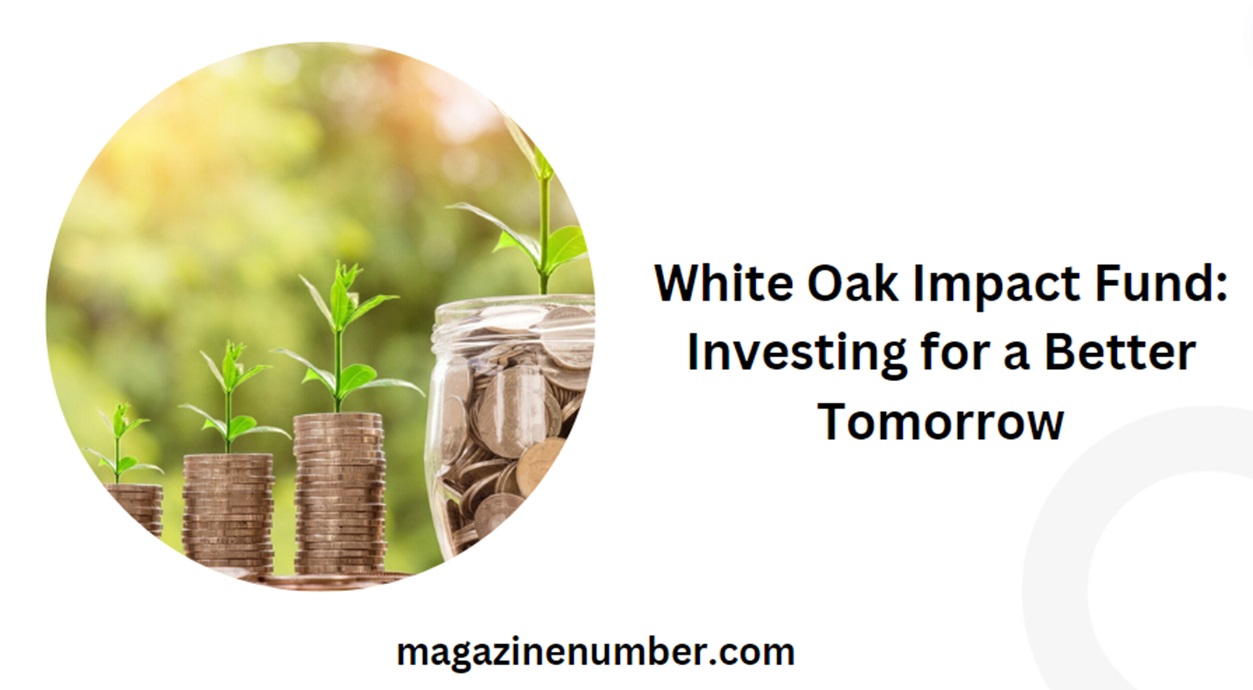White Oak Impact Fund
The financial world has seen a significant transformation over the past few decades, with a growing emphasis on sustainability and social responsibility. Among the various initiatives and funds that have emerged, the White Oak Impact Fund stands out as a remarkable example of how investment capital can be used to drive positive social and environmental change while still delivering competitive financial returns. This article delves into the intricacies of the White Oak Impact Fund, exploring its investment strategy, management structure, performance metrics, and notable case studies, providing a comprehensive understanding of its operations and impact.
Table of Contents
Overview of the White Oak Impact Fund
The White Oak Impact Fund is an innovative investment vehicle that combines financial goals with the mission of creating a significant positive impact on society and the environment. Established by a team of finance and social impact experts, the fund focuses on investing in companies, projects, and initiatives that address some of the most pressing global challenges, such as climate change, poverty, and inequality. The fund aims to achieve a dual objective: generating financial returns for its investors while driving measurable social and environmental benefits.
Investment Strategy
The investment strategy of the White Oak Impact Fund is designed to identify and support high-potential opportunities that align with its impact objectives. The fund employs a rigorous selection process to ensure that each investment meets its criteria for impact and financial viability.
Focus Areas
The White Oak Impact Fund targets a diverse range of sectors, each chosen for its potential to generate significant social or environmental benefits. Key focus areas include:
Renewable Energy
Investments in renewable energy projects are central to the fund’s strategy. By supporting solar, wind, and other clean energy initiatives, the fund aims to reduce greenhouse gas emissions, promote energy independence, and create sustainable jobs. Projects in this sector often involve the development of large-scale solar farms, wind turbines, and innovative energy storage solutions.
Affordable Housing
Access to affordable housing is a critical issue in many parts of the world. The White Oak Impact Fund invests in housing projects that provide safe, affordable, and sustainable living conditions for low-income families. These projects often include the construction of new housing units, the renovation of existing structures, and the development of supportive housing communities.
Healthcare
Improving access to quality healthcare is another priority for the fund. Investments in this sector focus on companies and initiatives that enhance healthcare delivery, reduce costs, and expand access to underserved populations. This can include funding for healthcare startups, supporting community health centers, and investing in medical technology innovations.
Education
Education is a powerful tool for breaking the cycle of poverty and inequality. The White Oak Impact Fund supports educational initiatives that aim to improve educational outcomes and provide opportunities for disadvantaged communities. This includes investments in early childhood education, K-12 programs, vocational training, and higher education institutions.
Criteria for Investment
The White Oak Impact Fund employs a set of rigorous criteria to evaluate potential investments. These criteria ensure that each investment aligns with the fund’s mission and has the potential to deliver both financial returns and significant impact.
Impact Potential
The potential for positive social or environmental impact is a primary consideration for the fund. Investments are selected based on their ability to address critical challenges and create measurable benefits. This includes evaluating the scale of impact, the number of beneficiaries, and the sustainability of the outcomes.
Financial Viability
While impact is a key focus, the fund also prioritizes financial viability. Each investment must demonstrate a strong potential for financial returns, ensuring that the fund can deliver value to its investors. This involves a thorough analysis of the business model, revenue streams, and market potential of each opportunity.
Scalability
The ability to scale and expand the impact is another important criterion. The fund seeks investments that have the potential to grow and reach a larger population over time. This includes assessing the scalability of the business model, the market demand, and the capacity for growth.
Sustainability
Sustainability is a core principle of the White Oak Impact Fund. Investments must be designed to deliver long-term benefits and minimize negative environmental impacts. This involves evaluating the environmental footprint of each project, the use of sustainable practices, and the potential for lasting change.
Fund Management
Effective management is crucial to the success of the White Oak Impact Fund. The fund is overseen by a team of experienced professionals with expertise in finance, social enterprise, and sustainable development. The management team is responsible for developing and executing the fund’s strategy, identifying and evaluating investment opportunities, and ensuring that each investment aligns with the fund’s mission.
Team
The White Oak Impact Fund’s management team comprises individuals with diverse backgrounds and skill sets. Key members of the team include:
Fund Managers
Fund managers are responsible for the overall strategy and decision-making process. They bring extensive experience in finance and investment management, ensuring that the fund’s portfolio is well-diversified and aligned with its objectives. Fund managers also play a crucial role in engaging with investors and stakeholders, providing regular updates on the fund’s performance and impact.
Analysts
Analysts conduct in-depth research and due diligence on potential investments. They evaluate the financial viability, impact potential, and scalability of each opportunity, providing detailed reports and recommendations to the fund managers. Analysts also monitor the performance of existing investments, ensuring that they continue to meet the fund’s criteria.
Impact Officers
Impact officers are responsible for ensuring that each investment aligns with the fund’s social and environmental objectives. They develop and implement impact measurement frameworks, conduct regular assessments, and report on the progress of each investment. Impact officers also work closely with portfolio companies to support their impact strategies and ensure that they deliver on their promises.
Governance
The White Oak Impact Fund adheres to strict governance practices to ensure transparency, accountability, and integrity. Key governance practices include:
Regular Reporting
Investors receive periodic reports on the financial performance and impact metrics of the fund. These reports provide detailed information on the progress of each investment, including financial returns, impact outcomes, and any challenges or risks. Regular reporting ensures that investors are well-informed and can track the performance of their investments.
Independent Audits
The fund undergoes annual audits by third-party firms to verify its financial statements and impact claims. Independent audits provide an objective assessment of the fund’s performance, ensuring that it adheres to best practices and maintains the highest standards of transparency and accountability.
Advisory Board
The fund is supported by an advisory board comprising experts in relevant fields, such as finance, social enterprise, and sustainable development. The advisory board provides strategic guidance and oversight, helping to ensure that the fund’s investments align with its mission and deliver meaningful impact. Board members also bring valuable insights and connections, supporting the fund’s growth and development.
Performance Metrics
Measuring the performance of the White Oak Impact Fund involves assessing both financial returns and impact outcomes. The fund employs a range of metrics to evaluate its performance and ensure that it delivers on its dual objectives.
Financial Returns
The fund aims to deliver competitive financial returns comparable to traditional investment funds. Key performance indicators for financial returns include:
Return on Investment (ROI)
ROI measures the financial gain from each investment, comparing the initial investment amount to the profits generated. A high ROI indicates that the fund’s investments are delivering strong financial returns.
Net Asset Value (NAV)
NAV represents the total value of the fund’s assets minus liabilities. It provides a snapshot of the fund’s overall financial health and performance. A growing NAV indicates that the fund’s portfolio is appreciating in value.
Impact Measurement
The White Oak Impact Fund uses various metrics to assess the social and environmental impact of its investments. These metrics are designed to provide a comprehensive understanding of the fund’s impact and ensure that it delivers meaningful benefits.
Carbon Footprint Reduction
Investments in renewable energy projects are measured based on their ability to reduce greenhouse gas emissions. This involves calculating the amount of carbon emissions avoided through the use of clean energy sources, such as solar and wind.
Number of Beneficiaries
The fund tracks the number of individuals positively impacted by its investments. This includes measuring the number of people who gain access to affordable housing, healthcare, or education as a result of the fund’s support.
Educational Outcomes
For investments in the education sector, the fund assesses improvements in educational outcomes. This includes tracking metrics such as literacy rates, graduation rates, and the number of students who complete vocational training programs.
Case Studies
The impact of the White Oak Impact Fund can be illustrated through several notable case studies. These examples highlight the fund’s ability to drive positive change while delivering financial returns.
Renewable Energy Project
One of the fund’s significant investments is in a solar energy project in Sub-Saharan Africa. This project aims to address the region’s energy access challenges and reduce reliance on fossil fuels. Key outcomes of the project include:
Reduced Carbon Emissions
By replacing diesel generators with solar panels, the project significantly reduces greenhouse gas emissions. This contributes to global efforts to combat climate change and improve air quality in the region.
Created Jobs
The project provides employment opportunities for local communities, including jobs in construction, maintenance, and operations. This supports economic development and improves livelihoods for individuals and families.
Improved Energy Access
The solar energy project supplies electricity to remote areas that previously had limited or no access to power. This enhances the quality of life for residents, enabling them to power homes, schools, and businesses.
Affordable Housing Initiative
Another key investment is in an affordable housing development in Latin America. This initiative addresses the housing crisis in the region by providing safe, affordable, and sustainable living conditions for low-income families. Key outcomes of the initiative include:
Provided Homes
The project has constructed over 1,000 affordable housing units, offering safe and comfortable living conditions for families in need. The homes are designed to be energy-efficient and environmentally sustainable.
Enhanced Living Conditions
The housing development includes infrastructure improvements, such as clean water, sanitation, and electricity. These enhancements contribute to better health and well-being for residents.
Promoted Community Development
The initiative also includes community centers, educational facilities, and recreational spaces. These amenities support community development and provide opportunities for social interaction, education, and recreation.
Healthcare Innovation
The White Oak Impact Fund has also invested in a healthcare startup that aims to improve access to quality healthcare in underserved areas. The startup leverages technology to provide remote consultations, diagnostic services, and treatment plans. Key outcomes of this investment include:
Expanded Healthcare Access
The startup’s telemedicine platform enables individuals in remote or underserved areas to access healthcare services. This reduces the need for travel and provides timely medical support.
Reduced Healthcare Costs
By offering remote consultations and diagnostic services, the startup helps to reduce healthcare costs for patients. This makes healthcare more affordable and accessible, particularly for low-income individuals and families.
Improved Health Outcomes
The startup’s services have led to improved health outcomes for patients, including early diagnosis and treatment of medical conditions. This contributes to better overall health and well-being for the communities served.
Challenges and Opportunities
While the White Oak Impact Fund has achieved significant success, it also faces challenges and opportunities in its mission to drive positive change.
Challenges
Balancing Impact and Returns
One of the primary challenges is balancing the dual objectives of financial returns and impact. Ensuring that each investment delivers both can be complex, requiring careful selection and management of opportunities.
Measuring Impact
Measuring social and environmental impact can be challenging, particularly when dealing with diverse and complex issues. The fund must develop robust impact measurement frameworks and continuously refine its metrics to ensure accurate and meaningful assessments.
Scaling Investments
Scaling investments to reach a larger population and maximize impact can be difficult. The fund must identify scalable business models and support portfolio companies in their growth and expansion efforts.
Opportunities
Growing Demand for Impact Investing
The demand for impact investing is growing, driven by increasing awareness of social and environmental issues. This presents opportunities for the White Oak Impact Fund to attract more investors and expand its portfolio.
Innovation and Technology
Advances in technology and innovation provide new opportunities for the fund to drive impact. This includes leveraging technology to improve healthcare access, enhance educational outcomes, and develop sustainable energy solutions.
Partnerships and Collaborations
Collaborating with other impact investors, non-profit organizations, and governments can enhance the fund’s ability to achieve its mission. Partnerships can provide additional resources, expertise, and support for the fund’s initiatives.
Conclusion
The White Oak Impact Fund exemplifies how investment capital can be leveraged to achieve both financial returns and significant social and environmental impacts. By focusing on sectors that address global challenges and adhering to strict investment criteria and governance practices, the fund strives to make a meaningful difference in the world while providing value to its investors.
The fund’s investment strategy, management structure, performance metrics, and notable case studies demonstrate its commitment to driving positive change. Despite the challenges, the fund continues to explore new opportunities and innovate to maximize its impact.
As the demand for impact investing grows, the White Oak Impact Fund is well-positioned to lead the way in creating a more sustainable and equitable future. By aligning financial goals with the mission of creating positive change, the fund serves as a powerful example of how finance can be a force for good.
Read our blogs at Magazine Number.



